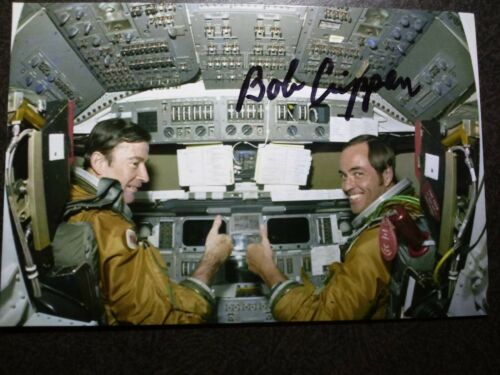-40%
ROBERT CRIPPEN (BOB) Authentic Hand Signed Autograph 4X6 Photo - NASA ASTRONAUT
$ 0
- Description
- Size Guide
Description
NASA ASRRONAUT - ROBERT CRIPPEN (BOB) Hand Signed 4X6 Photo . is Hand Signed by ROBERT CRIPPEN (BOB) %100 Authentic Autograph! Autograph is BOLD & Looks AMAZING ! The photo is in Great condition & is a High Quality photo. Will be shipped SUPER FAST to you & will be Well packaged . I will ship to you . The SAME DAY you pay :) YES... I even ship on Saturday . Payment MUST be made in 3 days or less after this listing ends ! Combined s&h is Extra each additional listing . In the 3 day Period . Check out my other Low priced autographs & my Fantastic Feedback :) Ad my store to your follow list . I do list NEW Low priced Autographs EVERY DAY ! Upon Request . I do offer my Lifetime Guarantee COA . Just message me at Checkout . Thank you :) Amanda(born September 11, 1937) is an American retired naval officer and aviator, test pilot, aerospace engineer, and retired astronaut. He traveled into space four times: as Pilot of STS-1 in April 1981, the first Space Shuttle mission; and as Commander of STS-7 in June 1983, STS-41-C in April 1984, and STS-41-G in October 1984. Crippen received the Congressional Space Medal of Honor. Crippen participated in the recovery operations for the remains of crew members after the Space Shuttle Challenger disaster. Military careerCrippen was commissioned through the United States Navy's Aviation Officer Candidate School (AOCS) Program at Naval Air Station Pensacola, Florida.[2] He continued his flight training at Naval Air Station Whiting Field, Florida, and went from there to Naval Air Station Chase Field in Beeville, Texas, where he received his wings. As a Naval Aviator from June 1962 to November 1964, he made two deployments aboard the aircraft carrier USS Independence, flying the A-4 Skyhawk in Attack Squadron 72 (VA-72). He later attended the U.S. Air Force Aerospace Research Pilot School at Edwards Air Force Base, California. Upon graduation, he remained at Edwards as an instructor until he was picked for the USAF Manned Orbiting Laboratory (MOL) spaceflight program in October 1966.[2] He has logged more than 6,500 hours flying time, which includes more than 5,500 hours in jet aircraft. Crippen with a MOL spacesuitNASA career STS-1After the MOL program was cancelled, Crippen became part of NASA Astronaut Group 7 in September 1969. He served on the astronaut support crew for the Skylab 2, Skylab 3, and Skylab 4 missions, and for the Apollo-Soyuz Test Project mission. John Young and Crippen suiting up for the STS-1 mission Crippen was the pilot on STS-1, the first orbital test flight of the Space Shuttle. It was also the first manned vehicle to be flown into orbit without previous unmanned orbital testing and the first winged manned vehicle to launch with solid rocket boosters. was also the first winged reentry vehicle to return to a conventional runway landing. The mission lasted 54 hours, 20 minutes, 53 seconds.STS-7 Crippen served as the commander of STS-7, which was the second flight for the Orbiter Challenger. This was also the first mission with a five-person crew. During the six-day flight, the crew deployed satellites for Canada (ANIK C-2) and Indonesia (PALAPA B-1); operated the Canadian-built Remote Manipulator System (RMS) to perform the first deployment and retrieval exercise with the Shuttle Pallet Satellite (SPAS-01); conducted the first formation flying of the orbiter with a free-flying satellite (SPAS-02); carried and operated the first U.S./German cooperative materials science payload (OSTA-2); and operated the Continuous Flow Electrophoresis System (CFES) and the Monodisperse Latex Reactor (MLR) experiments, in addition to activating seven Getaway Specials. The mission duration was 146 hours, 23 minutes, 59 seconds.STS-41-C Crippen was the commander on STS-41-C, which was a seven-day mission during which the crew deployed the Long Duration Exposure Facility (LDEF); retrieved the ailing Solar Maximum Satellite, repaired it aboard the orbiting Challenger, and replaced it in orbit using the robot arm called the Remote Manipulator System (RMS); flight tested the Manned Maneuvering Units (MMU's) in two extravehicular activities (EVA); as well as operating the Cinema 360 and IMAX Camera Systems, and running a Bee Hive Honeycomb Structures student experiment. Mission duration was 167 hours, 40 minutes, 07 seconds.STS-41-G On his final spaceflight, Crippen served as the commander of STS-41-G. During the eight-day flight, the crew deployed the Earth Radiation Budget Satellite, conducted scientific observations of the Earth with the OSTA-3 pallet and Large Format Camera, and demonstrated potential satellite refueling with an EVA and associated hydrazine transfer. Mission duration was 8 days, 5 hours, 23 minutes, 33 seconds and concluded with a landing at Kennedy Space Center, Florida. Post-spaceflight careerAfter STS-41-G, Crippen was named Commander of the STS-62-A mission which would have launched from the new SLC-6 facility at Vandenberg Air Force Base, California. That mission was cancelled after the Space Shuttle Challenger disaster and SLC-6 was closed when the Air Force went back to launching satellites on the Titan III and Titan IV rockets.a Crippen was stationed at Kennedy Space Center, Florida, from July 1987 to December 1989, as Deputy Director, Shuttle Operations for NASA Headquarters. He was responsible for final Shuttle preparation, mission execution and return of the orbiter to KSC after landings at Edwards Air Force Base. From January 1990 to January 1992, he served as Director, Space Shuttle, at NASA Headquarters in Washington, D.C. As such, he was responsible for the overall Shuttle program requirements, performnce, and total program control, including budget, schedule and program content. He subsequently served as the Director of the Kennedy Space Center from January 1992 to January 1995.










